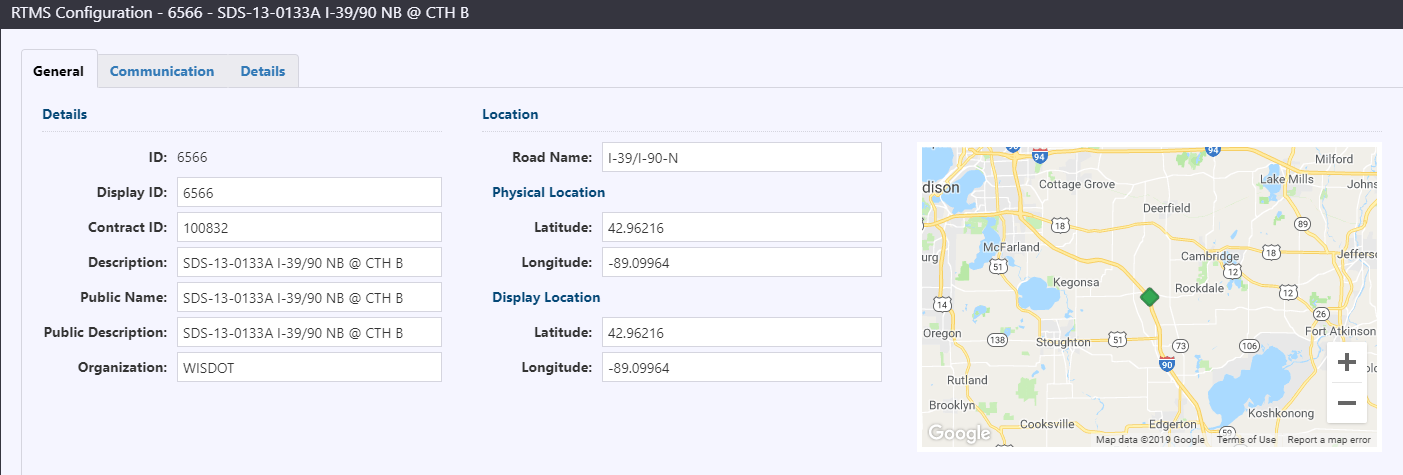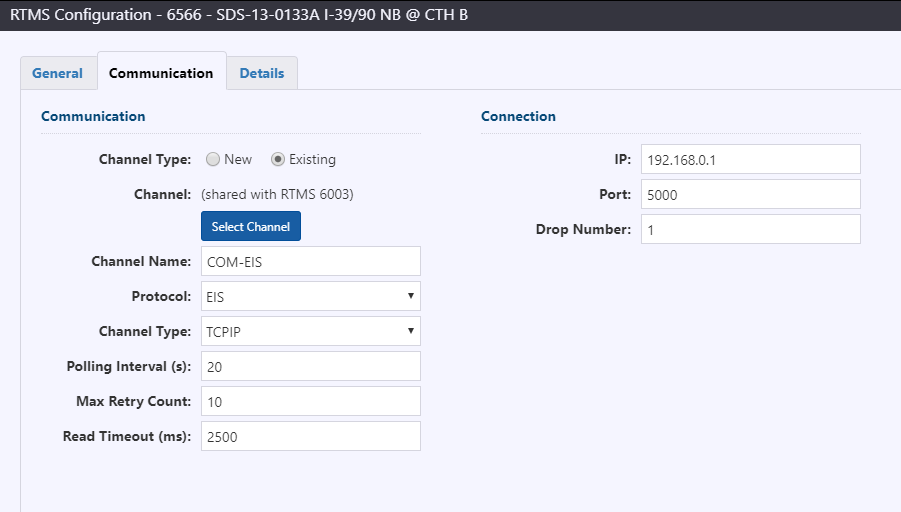RTMS
Traffic data from point data sources, such as an RTMS device, is used in the system by a Virtual Detection Station (VDS). A VDS aggregates data for all lanes in a given direction of travel at a point on the roadway. Lanes monitored by Point sources are assigned to VDS, and the VDS data is used in later travel time calculations and for roadway traffic conditions. A VDS can be associated with lanes from one or more Point sources, however a traffic detector lane can only be associated with one VDS.
RTMS Configuration
RTMS configuration is easily accessible from an existing device, either from the right-click menu on a device, or through the menu at the right of the device in the Traffic Detector List. New signs can be added by clicking Add Device at the bottom of the Traffic Detector List.
General Information
All signs require some common information. The general information included for a sign includes:
- ID: unique ID automatically assigned by the system upon creation
- Display ID: integer ID used for internal referencing of the devices
- Contract ID: string ID used for interfacing with external systems
- Description: description of the device
- Public Name: name used to refer to the device via ATMS API
- Public Description: description used to refer to the device in ATMS API
- Organization: string to describe what agency is responsible for the sign
- Road name: directional roadway associated with the device. Note, signs can also be assigned to the road 'Other' to denote non-agency managed roadways.
- Physical location: latitude and longitude for the physical location of the device
- Display location: latitude and longitude to use as the location for mapping

Communication
Information needed to determine communication to the sign is grouped into Communication, Connection, and Credentials.
Communication to signs uses the concept of channels, which represent a series-based communication to device(s) on the channel. IP-based multi-drop devices, i.e. those at the same IP address and port must share a channel.
A new channel can be created from the communication screen, or an existing channel can be selected. Clicking select channel will provide a window with a list of configured channels, including other devices currently configured to use that channel.

A new channel can be created from the communication screen, or an existing channel can be selected. Clicking select channel will provide a window with a list of configured channels, including other devices currently configured to use that channel.
For each channel, the following information is required:
- Channel Name: name to use to refer to the channel
- Protocol: communication protocol to communicate with the sign. Currently supported protocols include EIS, EISOLD (EIS X3), and Wavetronix
- Connection Type: communication type. Currently supported is TCPIP
- Polling Interval: period of time between successive polls to a device
- Max Retry Count: number of times to attempt a poll if the initial poll is unsuccessful
- Read Timeout: period of time to wait for a response
Connection information required for a sign includes three items:
- IP: device IP address
- Port: port for device
- Controller Address: address for multi-drop communication
Details
Configuration of zones required to configure a traffic detector is included under Details. Zones can be edited or deleted from the list, or added via the plus button at the bottom.

The information required for each zone includes the following:
- Zone: zone from the traffic detector (EIS and Wavetronix devices are 0-indexed, EISOLD devices are 1-indexed)
- Roadway: directional roadway associated with the detector. Note, signs can also be assigned to the road 'Other' to denote non-agency managed roadways.
- Lane: numerical indicator of roadway lane.
- Description: text description of the roadway lane
- VDS: system populate to denote which, if any, VDS is associated with the lane
- External Detector ID: integer ID used for interfacing with external systems
RTMS Parameters
| PARAMETER | DESCRIPTION |
|---|---|
| Max Volume | Maximum valid volume |
| Min Volume | Minimum valid volume |
| Max Speed | Maximum valid speed |
| Min Speed | Minimum valid speed |